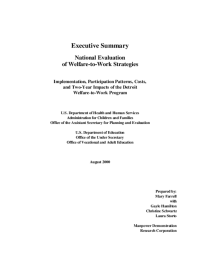Implementation, Participation Patterns, Costs, and Two-Year Impacts of the Detroit Welfare-to-Work Program
Michigan’s current welfare-to-work program evolved over the past decade from one that emphasized participation in education and training activities to one that focused on quick job entry as the route to financial independence for welfare recipients. In addition, it shifted many of the responsibilities previously performed by the welfare department to private and public organizations outside the welfare department and exempted fewer welfare recipients from participating in the program. The program that emerged became one of the keystones of Michigan’s overall welfare reform program, which was approved for implementation under the 1996 law.
This report examines the welfare-to-work programs operated in two of Detroit’s welfare districts: Fullerton-Jeffries and Hamtramck. It describes Michigan Opportunity and Skills Training (MOST), an education-focused program that was in place in these two offices in 1992 at the start of the evaluation, and the transition to Work First, an employment-focused program emphasizing job search services that was implemented in October 1994 and is one component of Michigan’s current welfare reform program. It follows for two years the welfare recipients who were assigned to MOST, almost one-quarter of whom were referred to the Work First program within the two-year period, and examines the types of services and messages that they received, the cost of both strategies, and the effects of the treatment received on welfare receipt, employment, and earnings. It follows an early group of individuals for three years.
The Detroit welfare-to-work program is being evaluated as part of the National Evaluation of Welfare-to-Work Strategies (NEWWS Evaluation; formerly called the JOBS Evaluation), conducted by the MDRC under contract to the U.S. Department of Health and Human Services, with support from the U.S. Department of Education and the W. K. Kellogg Foundation. NEWWS is a comprehensive study of 11 welfare-to-work programs in seven sites. Throughout this report, comparisons are made between the Detroit program and the other NEWWS programs. Two recently released reports provide a more comprehensive comparison among all programs, including results on children’s well-being, child care use while employed, supports provided to individuals who leave welfare for employment, and additional measures of self-sufficiency. A future report will examine five-year results for all programs and will compare program benefits with program costs.







